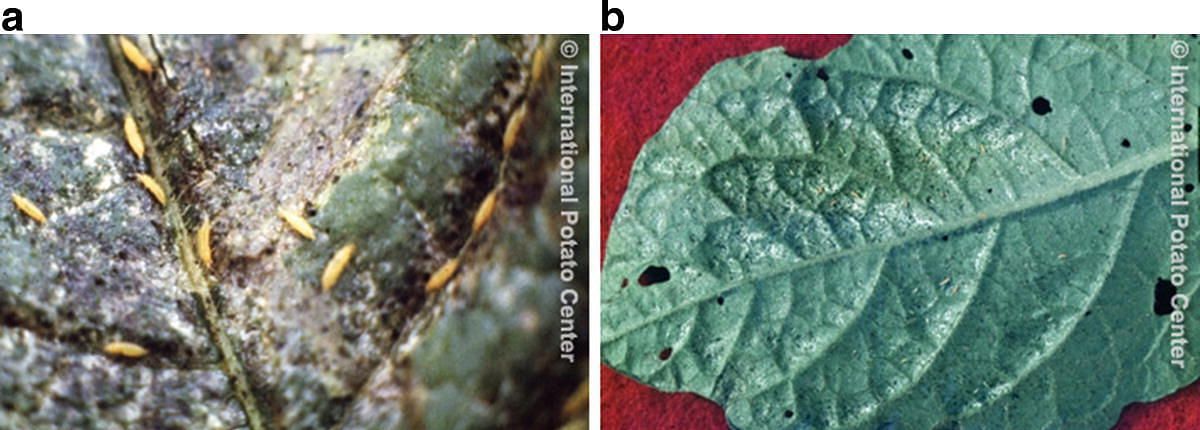Scientific description of Thrips (2020)
Based on J. Kroschel. et al. (2020) Insect Pests Affecting Potatoes in Tropical, Subtropical, and Temperate Regions. In: Campos H., Ortiz O. (eds) The Potato Crop. Springer, Cham
The authors of this content are Jürgen Kroschel, Norma Mujica, Joshua Okonya, Andrei Alyokhin
Frankliniella occidentalis (Pergande), Thrips tabaci Lindeman (Thysanoptera, Thripidae)
Distribution
The western flower thrips Frankliniella occidentalis originated in western North America and has since become a major pest on many crops across the US and around the world (image below). The onion thrip Thrips tabaci is thought to have originated in the Mediterranean region but is now found on all continents except Antarctica.

Pale or brown nymphs and darker adults of Frankliniella occidentalis on the underside of potato leaves (a), and symptoms of thrips feeding causes silvering on underside of a potato leaf (b). (Courtesy: CIP)
Host range
F. occidentalis feeds on more than 200 crops in over 50 genera and this includes vegetables, fruit trees, and ornamentals.
Symptoms of infestation
Thrips can cause major damage mainly during dry climatic conditions. Because of heavy feeding, potato leaves develop a silver or chlorotic dotting of the tissues and become deformed. The silver color is due to the emptying of the cells (CIP 1996; CABI 2017i, j; Learmonth 2017).
Impacts on production losses
Thrips are minor pest of potato. Some species are vectors for tomato spotted wilt virus (TSWV), with western flower thrips (F. occidentalis) as the most important virus vector. The virus reduces crop yield and tuber quality (CABI 2017i, j).
Methods of prevention and control
- Cultural practices.
Thrips feed on a wide range of plants, including weeds from which they can invade potato crops. Therefore, weed control is a good management strategy for this pest. Susceptible crops (onion, tomato, corn, artichoke, and pumpkin) should not be planted next to a potato crop. Any plants showing tomato spotted wilt virus symptoms should be removed (CIP 1996; CABI i, j; Learmonth 2017). - Behavioral control.
Yellow or blue (especially for F. occidentalis) sticky traps can be used to monitor the presence of thrips. - Biological control.
Various species of the worldwide anthocorid genus Orius are used in biological control against thrips, and these bugs are important as predators in many natural populations. Amblyseius swirskii Athias-Henriot and Neoseiulus cucumeris Oudemans are two of the most widely used predatory mites in the biological control of F. occidentalis.
Fungal pathogens and nematodes, such as Beauveria bassiana and Steinernema feltiae, are also being used commercially. Parasitoids include Ceranisus menes Walker for the western flower thrip (CABI 2017i, j). - Chemical control.
Low to medium toxicity pesticides used against thrips include Spinosad, Spinetoram, and Abamectin (Bentley and Rice 2015).
